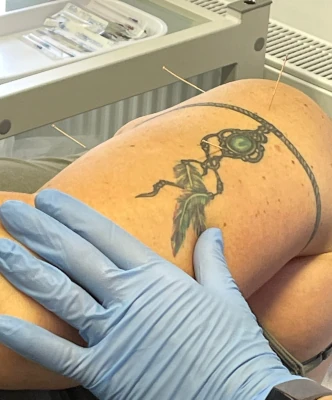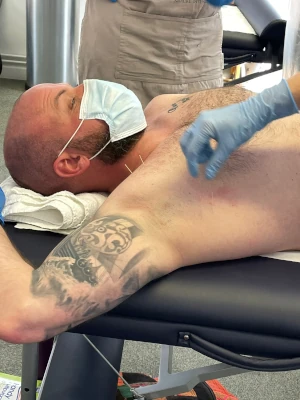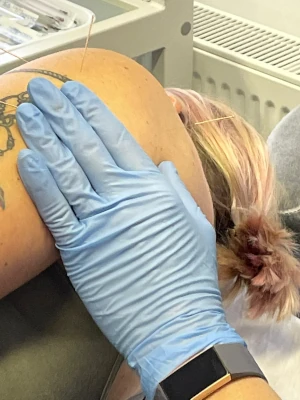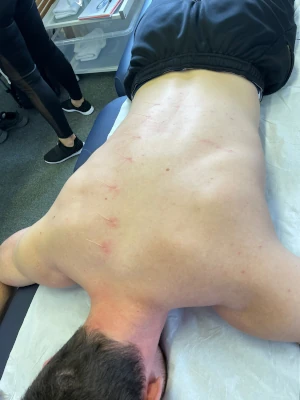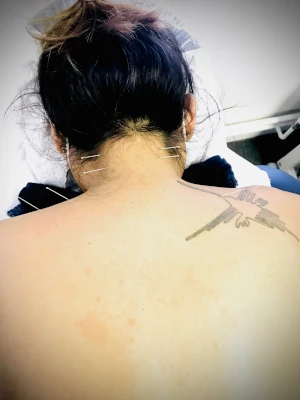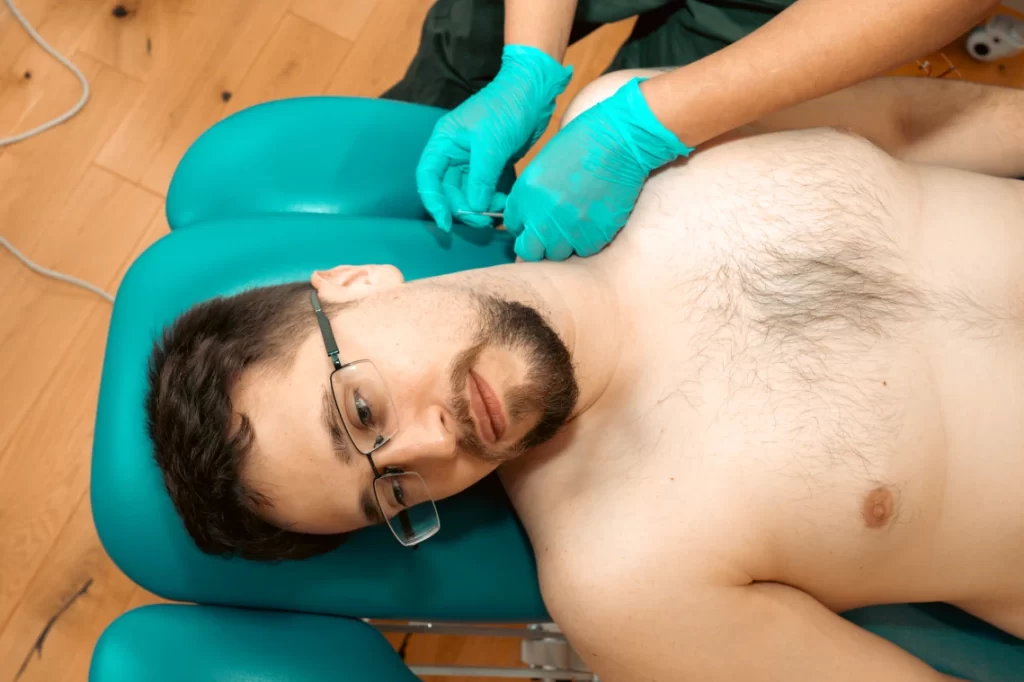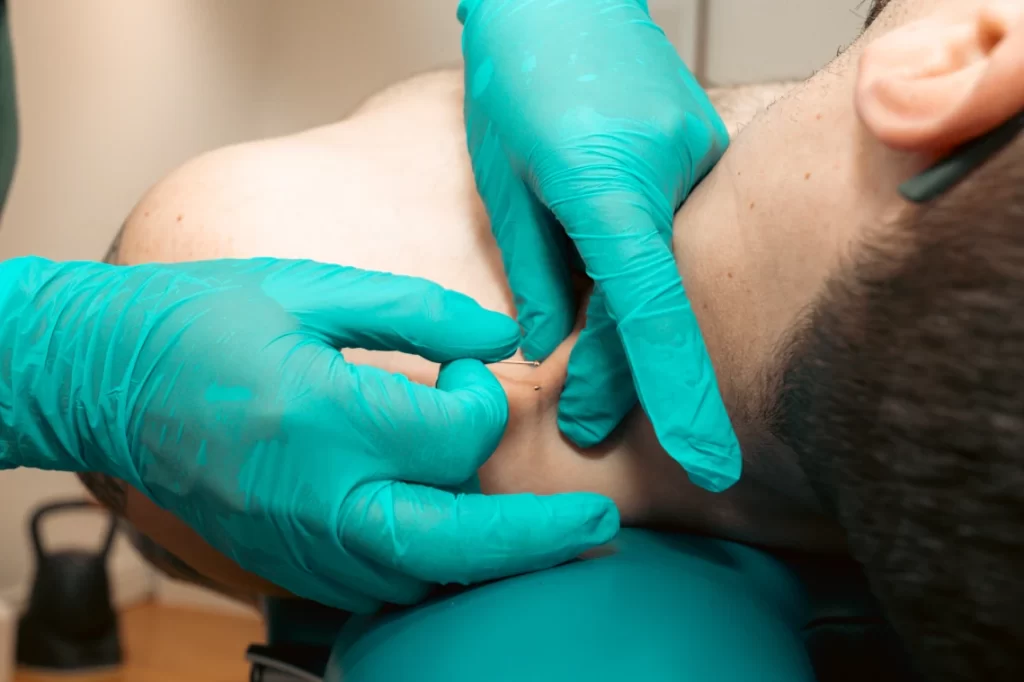My Services

What is Dry Needling?
Dry needling is a treatment technique whereby a sterile, single-use, fine filament needle (acupuncture needle) is inserted into the muscle to decrease pain and improve function through the release of myofascial trigger points (knots in muscle).
What is the Difference Between Dry Needling and Acupuncture?
The main difference between dry needling and acupuncture is the theory behind why the methods work. Dry needling is not the same as acupuncture, although there are similarities between the two techniques. Dry needling’s primarily focused on reducing pain and restoring function through the release of myofascial trigger points in the muscle. In comparison, acupuncture focuses on treating medical conditions by restoring the flow of energy (Qi) through critical points in the body (meridians) to restore balance.
What is a Myofascial Trigger Point?
A myofascial trigger point, also known as a knot in the muscle, is a group of muscle fibres that have shortened when activated but have not lengthened back to a relaxed state after use. A myofascial trigger point develops a sensitive nodule in the muscle (Simons, Travell & Simons, 1999). In addition to this nodule, the remainder of the muscle also tightens to compensate (Simons et al., 1999; Simons, 2002). This hypersensitivity occurs as the muscle fibres become so tight that they compress the capillaries and nerves that supply them (McPartland, 2004; Simons et al., 1999). As a result, the muscle cannot frequently move, obtain a fresh blood supply containing oxygen and nutrients, or flush out additional acidic chemicals (McPartland, 2004; Simons et al., 1999). The presence of a myofascial trigger point in a muscle can lead to discomfort with touch, movement and stretching, decreased joint motion, and even a temporary loss of coordination (Simons et al., 1999).
How Does This Practice Work?
The treatment assists with decreasing local muscular pain and improve function by restoring a muscle’s natural ability to lengthen and shorten by releasing myofascial trigger points.
Dry needling can assist:
- to help release myofascial trigger points (muscle knots);
- to assist with pain management;
- to restore movement at a joint if inhibited by myofascial trigger points.
Where Does It Fit Into Your Rehabilitation Plan??
This is one of many techniques that your physiotherapist can utilise to assist with your rehabilitation. We combine it with other physiotherapy techniques, including massage, manual therapy, and exercise prescription.
What are the Side Effects?
Every form of treatment can carry an associated risk. Your physiotherapist can explain the risks and determine whether the treatment is suitable for you based on your injury and general health. When dry needling occurs, single-use, sterile needles are always used and disposed of immediately after using a certified sharps container.
Is Dry Needling Safe?
Everybody is different and can respond differently to various treatment techniques, including dry needling. In addition to the benefits that practice can provide, some side effects may occur, including spotting or bruising, fainting, nausea, residual discomfort or even altered energy levels. However, these symptoms should last no longer than 24 to 48 hours after treatment.
Can You Exercise After Dry Needling?
We recommend avoiding strenuous or high impact activities immediately to allow the body time to recover and maximise the treatment benefits.
More info

What is Dry Needling?
Dry needling is a treatment technique whereby a sterile, single-use, fine filament needle (acupuncture needle) is inserted into the muscle to decrease pain and improve function through the release of myofascial trigger points (knots in muscle).
What is the Difference Between Dry Needling and Acupuncture?
The main difference between dry needling and acupuncture is the theory behind why the methods work. Dry needling is not the same as acupuncture, although there are similarities between the two techniques. Dry needling’s primarily focused on reducing pain and restoring function through the release of myofascial trigger points in the muscle. In comparison, acupuncture focuses on treating medical conditions by restoring the flow of energy (Qi) through critical points in the body (meridians) to restore balance.
What is a Myofascial Trigger Point?
A myofascial trigger point, also known as a knot in the muscle, is a group of muscle fibres that have shortened when activated but have not lengthened back to a relaxed state after use. A myofascial trigger point develops a sensitive nodule in the muscle (Simons, Travell & Simons, 1999). In addition to this nodule, the remainder of the muscle also tightens to compensate (Simons et al., 1999; Simons, 2002). This hypersensitivity occurs as the muscle fibres become so tight that they compress the capillaries and nerves that supply them (McPartland, 2004; Simons et al., 1999). As a result, the muscle cannot frequently move, obtain a fresh blood supply containing oxygen and nutrients, or flush out additional acidic chemicals (McPartland, 2004; Simons et al., 1999). The presence of a myofascial trigger point in a muscle can lead to discomfort with touch, movement and stretching, decreased joint motion, and even a temporary loss of coordination (Simons et al., 1999).
How Does This Practice Work?
The treatment assists with decreasing local muscular pain and improve function by restoring a muscle’s natural ability to lengthen and shorten by releasing myofascial trigger points.
Dry needling can assist:
- to help release myofascial trigger points (muscle knots);
- to assist with pain management;
- to restore movement at a joint if inhibited by myofascial trigger points.
Where Does It Fit Into Your Rehabilitation Plan??
This is one of many techniques that your physiotherapist can utilise to assist with your rehabilitation. We combine it with other physiotherapy techniques, including massage, manual therapy, and exercise prescription.
What are the Side Effects?
Every form of treatment can carry an associated risk. Your physiotherapist can explain the risks and determine whether the treatment is suitable for you based on your injury and general health. When dry needling occurs, single-use, sterile needles are always used and disposed of immediately after using a certified sharps container.
Is Dry Needling Safe?
Everybody is different and can respond differently to various treatment techniques, including dry needling. In addition to the benefits that practice can provide, some side effects may occur, including spotting or bruising, fainting, nausea, residual discomfort or even altered energy levels. However, these symptoms should last no longer than 24 to 48 hours after treatment.
Can You Exercise After Dry Needling?
We recommend avoiding strenuous or high impact activities immediately to allow the body time to recover and maximise the treatment benefits.


